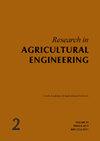利用新的电脑技术优化农地平整过程中的能源消耗
Q3 Agricultural and Biological Sciences
引用次数: 0
摘要
平整土地是土壤准备中最耗能的步骤之一。具体的土地平整作业有许多限制因素,如肥沃的表土保持,有限的允许坡度,特定的切填比等。这些限制使得土地平整的优化问题更加复杂。在本研究中,利用三种计算和进化方法,包括ICA、PSO、GA和MLS作为优化方法,以最小化土壤切割和填充体积,并确定优选的找平面。结果表明,与MLS相比,ICA在土地平整中具有最有效的能源优化解决方案,可节省总能耗的29% (17 GJ)。本研究探讨如何利用新的电脑技术优化土地平整工程的能源消耗,并将其与MLS方法作为基准进行比较。总而言之,ICA、PSO和GA在其最佳模型(1号模型)中分别节省了总能耗的29%、17%和10%,比MLS表现得更好。然而,发展中国家节约能源的巨大能力,不幸的是,缺乏教育和对化石燃料的过度补贴使这些潜力化为泡铁。本文章由计算机程序翻译,如有差异,请以英文原文为准。
Using new computer based techniques to optimise energy consumption in agricultural land levelling
Land levelling is one of the most energy-demanding steps in soil preparation. There are many limiting factors for a specific land levelling operation, such as fertile topsoil conservation, limited allowed slope, specific cut to fill ratio, etc. These limitations make optimisation problems of land levelling even more complicated. In this research, three computational and evolutionary methods including ICA, PSO, GA along with MLS were utilised as optimisation methods to minimise the soil cut and fill volumes and to determine the preferred levelling plane. The results indicated that ICA had the most efficient solution for the energy optimisation in the land levelling among the other investigated methods by saving 29% (17 GJ) of the total energy consumption compared with MLS. This study deals with optimising the energy consumption during land levelling projects using new computer-based techniques and compares them to the MLS method as a benchmark. All in all, ICA, PSO, and GA performed much better than MLS by saving 29, 17, and 10% of the total energy consumption in their best model (number 1 models), respectively. Nonetheless, with these great capacities for saving energy in developing countries, unfortunately, the lack of education and excess subsidies on fossil fuels nullify these potentials.
求助全文
通过发布文献求助,成功后即可免费获取论文全文。
去求助
来源期刊

Research in Agricultural Engineering
Engineering, agriculture-
CiteScore
1.40
自引率
0.00%
发文量
21
审稿时长
24 weeks
期刊介绍:
Original scientific papers, short communications, information, and studies covering all areas of agricultural engineering, agricultural technology, processing of agricultural products, countryside buildings and related problems from ecology, energetics, economy, ergonomy and applied physics and chemistry. Papers are published in English.
 求助内容:
求助内容: 应助结果提醒方式:
应助结果提醒方式:


